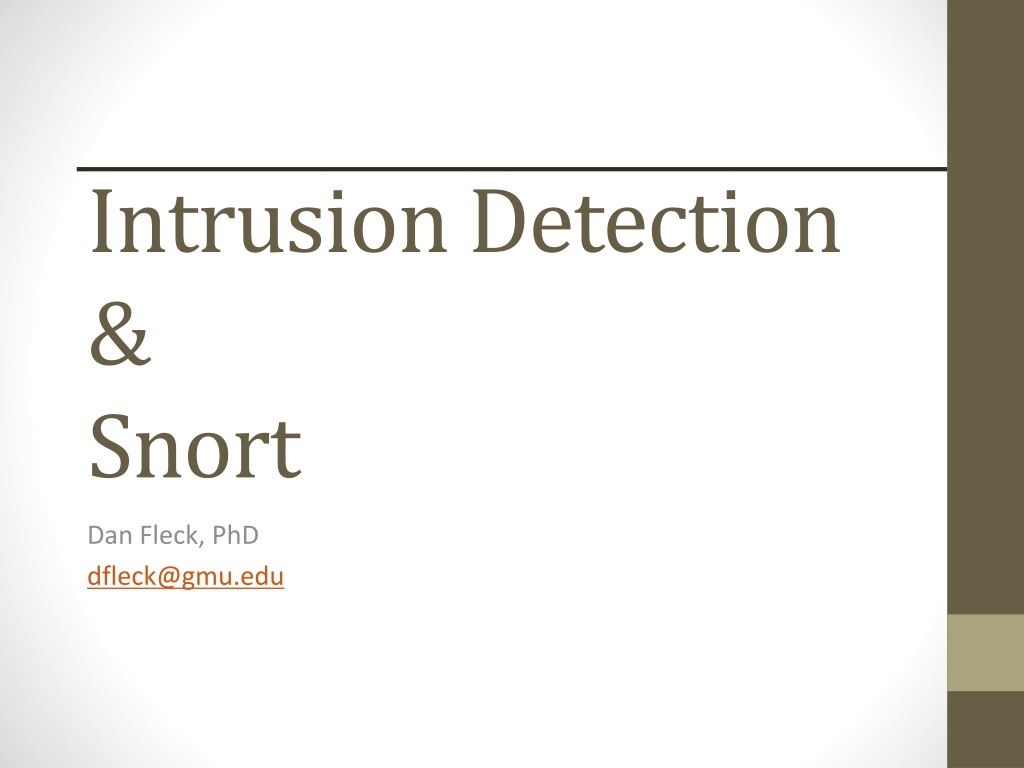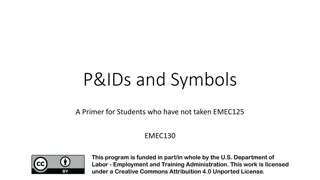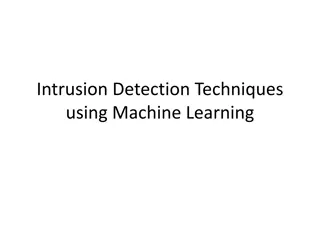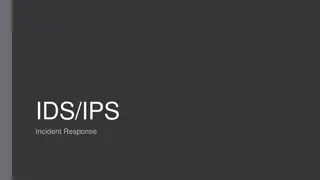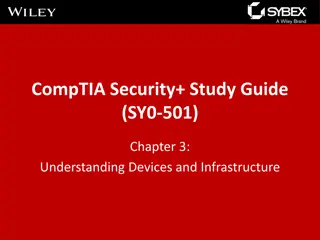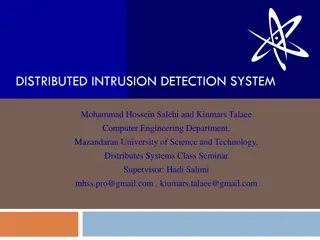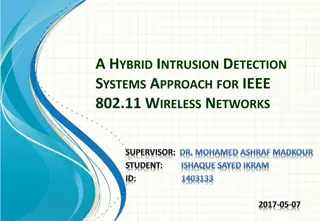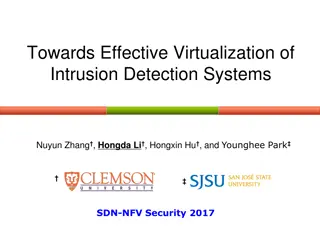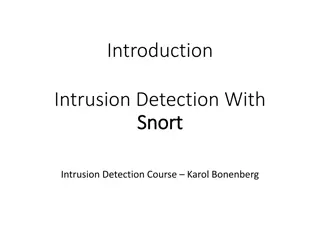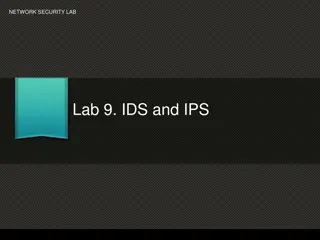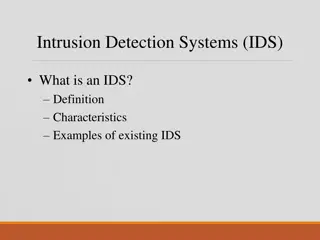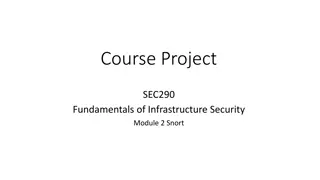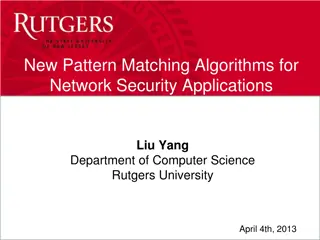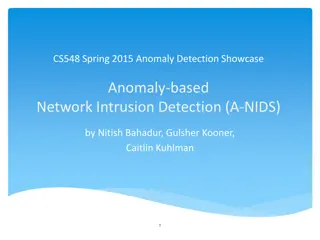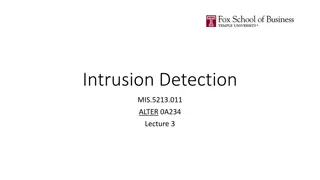Understanding Intrusion Detection Systems (IDS) and Snort in Network Security
Intrusion Detection Systems (IDS) play a crucial role in network security by analyzing traffic patterns and detecting anomalous behavior to send alerts. This summary covers the basics of IDS, differences between IDS and IPS, types of IDS (host-based and network-based), and the capabilities of Snort, a popular IDS tool. Learn about the various detection methods such as anomaly detection, misuse detection, and specification-based detection employed by IDS. Dive into the world of IDS to enhance your understanding of network security.
Download Presentation

Please find below an Image/Link to download the presentation.
The content on the website is provided AS IS for your information and personal use only. It may not be sold, licensed, or shared on other websites without obtaining consent from the author. Download presentation by click this link. If you encounter any issues during the download, it is possible that the publisher has removed the file from their server.
E N D
Presentation Transcript
Intrusion Detection & Snort Dan Fleck, PhD dfleck@gmu.edu
Intrusion Detection An intrusion detection system (IDS) analyzes traffic patterns and reacts to anomalous patterns by sending out alerts. Note that an IDS is inherently reactive; the attack has already begun when the IDS alerts. Firewall Internal LAN 2 IDS
Intrusion Detection: IDS vs IPS Firewall Internal LAN IPS Intrusion Prevention System Firewall Internal LAN 3 IDS What changes if I want to see all attempted attacks?
Firewall vs IDS vs IPS Firewall - A device or application that analyzes packet headers and enforces policy based on protocol type, source address, destination address, source port, and/or destination port. Packets that do not match policy are rejected. Intrusion Detection System - A device or application that analyzes whole packets, both header and payload, looking for known events. When a known event is detected a log message is generated detailing the event. Intrusion Prevention System - A device or application that analyzes whole packets, both header and payload, looking for known events. When a known event is detected the packet is rejected. Some devices are now combining all of these functions into a single security device (Smart Firewall, Next Gen Firewall, etc ). Snort can be run in IDS or IPS modes. 4 Source: http://security.stackexchange.com/questions/44931/difference-between-ids-and-ips-and-firewall
What do IDS detect? Anomaly detection: Activity that deviates from the normal behavior Misuse detection: Execution of code that results in break-ins Specifcation based detection: Activity involving privileged software that is inconsistent with respect to a policy/specification - D. Denning 5
Types of IDS Host Based IDS Installed locally on machines Monitoring local user activity Monitoring execution of system programs Monitoring local system logs Network IDS (NIDS) Sensors are installed at strategic locations on the network Monitor changes in traffic pattern/ connection requests Monitor Users network activity Deep Packet inspection In this lab we re discussing NIDS 6
Types of NIDS Signature Based IDS Compares incoming packets with known signatures E.g. Snort, Bro, Suricata, etc. Anomaly Detection Systems Learns the normal behavior of the system Generates alerts on packets that are different from the normal behavior 7
Signature based NIDS Current Standard is Signature Based Systems Problems: Zero-day attacks Polymorphic attacks Botnets Inexpensive re-usable IP addresses for attackers 8
Anomaly Detection NIDS Anomaly Detection (AD) Systems are capable of identifying Zero Day Attacks Problems: High False Positive Rates Labeled training data Our Focus: Web applications are popular targets 9
transAD & STAND (GMU Research) transAD TPR 90.17% FPR 0.17% STAND TPR 88.75% FPR 0.51% What do you think a signature-based detector would look like (roughly) FPR? TPR? 10
Attacks Detected by transAD Type of Attack HTTP GET Request Buffer Overflow /?slide=kashdan?slide=pawloski?slide=ascoli?slide=shukla?slide=kabba ni?slide=ascoli?slide=proteomics?slide=shukla?slide=shukla //forum/adminLogin.php?config[forum installed]= http://www.steelcitygray.com/auction/uploaded/golput/ID-RFI.txt?? Directory Traversal /resources/index.php?con=/../../../../../../../../etc/passwd Code Injection //resources-template.php?id=38-999.9+union+select+0 Script Attacks /.well-known/autoconfig/mail/config-v1.1.xml? emailaddress=********%40*********.***.*** Remote File Inclusion 11
Transduction based Anomaly Detection Compares how test packet fits with respect to the baseline A Strangeness function is used for comparing the test packet The sum of K-Nearest Neighbors distances is used as a measure of Strangeness 12
Intrusion Detection Errors There are two types of errors when considering any intrusion detection system. False negatives: a genuine attack is not detected. False positives: harmless behavior is misclassified as an attack. Which do think is a bigger problem? An intrusion detection system is: accurate: if it detects all genuine attacks; precise: if it never reports legitimate behavior as an attack. It is easy to make an IDS that is either accurate or precise! Why? It s hard to do both simultaneously. 13
Intrusion Detection Errors An undetected attack might lead to severe problems. But frequent false alarms can lead to the system being disabled or ignored. A perfect IDS would be both accurate and precise. Statistically, attacks are fairly rare events. Most intrusion detection systems suffer from the base-rate fallacy. Suppose that only 1% of traffic are actually attacks and the detection accuracy of your IDS is 90% and the false positive rate is 10%. If you have an alarm what is the chance it s a false alarm? 14
Base-Rate Fallacy Suppose that only 1% of traffic are actually attacks and the detection accuracy of your IDS is 90% and the false positive rate is 10%. What does that mean? the IDS classifies an attack as an attack with probability 90% (true positive) the IDS classifies a valid connection as attack with probability 10% (false positive) What is the probability that a connection flagged as an attack is not really an attack, i.e., a false positive? 15 There is approximately 92% chance that a raised alarm is false.
Equations for Base Rate Fallacy 1000 events: 990 benign, 10 attacks. 10% False alarm rate means: 99 false alarms 90% True positive rate means: 9 true alarms P(attack | alarm ) = 9/(9+99) = 0.08% Meaning, 92% of alarms are false alarms due to the base rate of benign traffic. This is to give you intuition about base rate, this can be done more formally using Bayes rule. 16
Lessons False negatives and false positives are both bad for an IDS. An IDS must be very accurate or suffer from the base rate fallacy. An IDS with too many errors becomes useless. 17
Snort: Our lab Signature-based detection system 1 CPU w/ 1000 signatures can process 500MBps (not great!) Getting faster in newer releases Can be run inline (IPS) or as a sniffer (IDS) First released in 1997 but still updated/maintained today Competitors: Suricata, Bro Detailed performance comparison: https://www.sans.org/reading-room/whitepapers/intrusion/open-source-ids-high-performance- shootout-35772 Snort Architecture 18
Snort: Rules http://manual.snort.org/node1.html http://books.gigatux.nl/mirror/snortids/0596006616/snortids- CHP-7-SECT-3.html alert tcp $EXTERNAL_NET any -> $HOME_NET any \ (msg:"SCAN SYN FIN";flags:SF; reference: arachnids,198; \ classtype:attempted-recon; sid:624; rev:1;) rule header ( rule options ) 19
Snort: Rule Header alert tcp $EXTERNAL_NET any -> $HOME_NET any \ (msg:"SCAN SYN FIN";flags:SF; reference: arachnids,198; \ classtype:attempted-recon; sid:624; rev:1;) Defines who the rule applies to (coarsly). alert tcp $EXTERNAL_NET any -> $HOME_NET any Src IP Src Port Dst IP Dst Port action protocol Direction 20
Snort: Rule Header Actions alert tcp $EXTERNAL_NET any -> $HOME_NET any \ (msg:"SCAN SYN FIN";flags:SF; reference: arachnids,198; \ classtype:attempted-recon; sid:624; rev:1;) alert tcp $EXTERNAL_NET any -> $HOME_NET any Src IP Src Port Direction Dst IP Dst Port action protocol 1. 2. 3. 4. 5. 6. 7. alert: Alerts and logs the packet when triggered. log: Only logs the packet when triggered. pass : Ignores or drops the packet or traffic matching. activate : Alerts then activates a dynamic rule or rules. dynamic : Ignores, until started by the activate rule, at which time, acts as a log rule. drop : block and log the packet reject : block the packet, log it, and then send a TCP reset if the protocol is TCP or an ICMP port unreachable message if the protocol is UDP. sdrop : block the packet but do not log it. 21 8.
Snort: Rule Header Protocol alert tcp $EXTERNAL_NET any -> $HOME_NET any \ (msg:"SCAN SYN FIN";flags:SF; reference: arachnids,198; \ classtype:attempted-recon; sid:624; rev:1;) alert tcp $EXTERNAL_NET any -> $HOME_NET any Src IP Src Port Direction Dst IP Dst Port action protocol Protocols: TCP, UDP, ICMP, and IP Future may include: ARP, IGRP, GRE, OSPF, RIP, IPX, etc. 22
Snort: Rule Header IP Src Port Dst IP Src IP Dst Port alert tcp $EXTERNAL_NET any -> $HOME_NET any alert tcp 192.168.1.0/24 any -> 192.168.1.0/24 1:1024 alert tcp ![192.168.1.0/24,10.1.1.0/24] any -> 192.168.1.44 $EXTERNAL_NET is a config value set in snort.conf. IP is specified also as dotted notation with CIDR masks. any is also valid. ! is the negation operator Multiple IP specifications can be included using square brackets [ ] and comma-separating. Do not add spaces! 23
Snort: Rule Header Port Src Port Dst IP Src IP Dst Port alert tcp $EXTERNAL_NET any -> $HOME_NET any alert tcp 192.168.1.0/24 any -> 192.168.1.0/24 1:1024 alert tcp ![192.168.1.0/24,10.1.1.0/24] any -> 192.168.1.44 Port can be specified as: any 1:1024 55: :55 -- any port -- ports 1 to 1024 inclusive -- ports 55 and higher -- ports 0 to 55 (inclusive) negation still works: !6000:6001 - matches any port except 6000 and 6001 24
Snort: Rule Header Direction Src Port Dst IP Src IP Dst Port alert tcp $EXTERNAL_NET any -> $HOME_NET any alert tcp 192.168.1.0/24 any -> 192.168.1.0/24 1:1024 alert tcp ![192.168.1.0/24,10.1.1.0/24] any -> 192.168.1.44 Direction can be specified as: -> From right IP/Port (source) to left IP/Port (destination) <> Any direction Note: <- does not exist so the snort rules always read consistently. 25
Snort: Rule Options alert tcp $EXTERNAL_NET any -> $HOME_NET any \ (msg:"SCAN SYN FIN";flags:SF; reference: arachnids,198; \ classtype:attempted-recon; sid:624; rev:1;) name:value; msg: <sample message> Logs message into /var/snort/log flags: <AFPRSU210> Matches specific TCP flags content: <text> Matches specified text in packet content: |<hexadecimal>| Matches specified hex chars sid: <snort ID> Unique number to identify rules easily. Your rules should use SIDs > 1,000,000 rev: <revision #> Rule revision number reference:<ref> Where to get more info about the rule gid:<generator ID> Identifies which part of Snort generated the alert. See /etc/snort/gen-msg.map for values 26
Snort: More Rule Options Read the docs.. there are MANY more options: http://manual.snort.org/node1.html 3.5 Payload Detection Rule Options 3.5.1 content 3.5.2 protected_content 3.5.3 hash 3.5.4 length 3.5.5 nocase 3.5.6 rawbytes 3.5.7 depth 3.5.8 offset 3.5.9 distance 3.5.10 within 3.5.11 http_client_body 3.5.12 http_cookie 3.5.13 http_raw_cookie 3.5.14 http_header 3.5.15 http_raw_header 3.5.16 http_method 3.5.17 http_uri 3.5.18 http_raw_uri 3.5.19 http_stat_code 3.5.20 http_stat_msg 3.5.21 http_encode 3.5.22 fast_pattern 3.5.23 uricontent 3.5.24 urilen 3.5.25 isdataat 3.5.26 pcre 3.5.27 pkt_data 3.5.28 file_data 3.5.29 base64_decode 3.5.30 base64_data 3.5.31 byte_test 3.5.32 byte_jump 3.5.33 byte_extract 3.5.34 ftpbounce 3.5.35 asn1 3.5.36 cvs 3.5.37 dce_iface 3.5.38 dce_opnum 3.5.39 dce_stub_data 3.5.40 sip_method 3.5.41 sip_stat_code 3.5.42 sip_header 3.5.43 sip_body 3.5.44 gtp_type 3.5.45 gtp_info 3.5.46 3.5.47 ssl_version 3.5.48 ssl_state 3.5.49 Payload Detection Quick Reference 3.6 Non-Payload Detection Rule Options 3.6.1 fragoffset 3.6.2 ttl 3.6.3 tos 3.6.4 id 3.6.5 ipopts 3.6.6 fragbits 3.6.7 dsize 3.6.8 flags 3.6.9 flow 3.6.10 flowbits 3.6.11 seq 3.6.12 ack 3.6.13 window 3.6.14 itype 3.6.15 icode 3.6.16 icmp_id 3.6.17 icmp_seq 3.6.18 rpc 3.6.19 ip_proto 3.6.20 sameip 3.6.21 stream_reassemble 3.6.22 stream_size 3.6.23 Non-Payload Detection Quick Reference 27
Snort rule examples 1. alert tcp any any -> any 21 (flow:to_server,established; \ content:"root"; pcre:"/user\s+root/i";) What does it do? Looks for root user login attempts on FTP server (port 21) 28
Snort: Try it out! Lets build two new rules to see how they work Rule 1: Alert if a URI is longer than 250 bytes. Rule 2: Alert on .edu websites that also say university in the page somewhere. (Because we love school!!) Wouldn t this be more fun in IPS mode? 29
Snort rule examples This is a real rule from malware-tools.rules alert tcp $EXTERNAL_NET any -> $HOME_NET $HTTP_PORTS (msg:"MALWARE- TOOLS HOIC http denial of service attack"; flow:to_server,established; content:"User-Agent|3A 20 20|Mozilla"; fast_pattern:only; http_header; content:"Referer|3A 20 20|http"; http_header; content:!"Connection: keep- alive"; nocase; detection_filter:track by_src, count 17, seconds 10; metadata:policy balanced-ips drop, policy security-ips drop, service http; reference:url,blog.spiderlabs.com/2012/01/hoic-ddos-analysis-and- detection.html; classtype:denial-of-service; sid:21513; rev:6;) 30
Snort rule examples This is a real rule from blacklist.rules alert udp $HOME_NET any -> any 53 (msg:"BLACKLIST DNS request for known malware domain guest-access.net - Gauss "; flow:to_server; byte_test:1,!&,0xF8,2; content:"|0C|guest-access|03|net|00|"; fast_pattern:only; metadata:impact_flag red, policy balanced-ips drop, policy security-ips drop, service dns; reference:url,gauss.crysys.hu/; reference:url,www.securelist.com/en/blog/208193767/Gauss_Nation_state_cyber _surveillance_meets_banking_Trojan; classtype:trojan-activity; sid:23799; rev:2;) 31
Snort rule examples This is a real rule from os-windows.rules alert tcp $EXTERNAL_NET $FILE_DATA_PORTS -> $HOME_NET any (msg:"OS- WINDOWS Microsoft Windows Object Packager ClickOnce object remote code execution attempt"; flow:to_client,established; flowbits:isset,file.ppsx&file.zip; file_data; content:"uuid:48fd9e68-0958-11dc-9770-9797abb443b9"; fast_pattern:only; content:"2007-05-23T15:06:10-03:00"; metadata:policy balanced-ips drop, policy security-ips drop, service ftp-data, service http, service imap, service pop3; reference:cve,2012-0013; reference:url,technet.microsoft.com/en-us/security/bulletin/ms12-005; classtype:attempted-user; sid:26068; rev:3;) 32
For the lab Put your rules in: /etc/snort/rules/local.rules The rules included in the default download are old and terrible. To really play with Snort you need a current ruleset. One place to get them is snort.org The nocase option is a content-modifier to ignore case. Put it right after content it should modify: alert tcp $EXTERNAL_NET any -> $TELNET_SERVERS 23 ( sid: 210; rev: 3; msg: "BACKDOOR attempt"; flow: to_server,established; content: "backdoor"; nocase; classtype: attempted-admin;) Remember that payload rules don t work on encrypted traffic! (SSL, etc..) Use A console to debug alerts on the console Use k none to disable tcp checksums 33
References http://paginas.fe.up.pt/~mgi98020/pgr/writing_snort_rules.ht m#Basics http://www.scmagazine.com/intrusion-detection- systems/products/91/0/ http://books.gigatux.nl/mirror/snortids/0596006616/snortids- CHP-7-SECT-3.html http://seclists.org/snort/2012/q3/894 34
